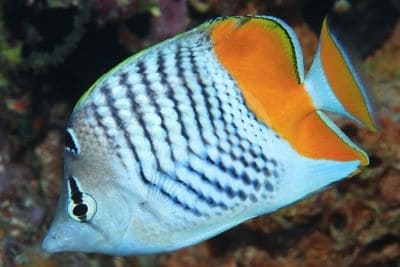Home › Sea Animals › Marine › Vertebrates › Butterflyfish › Atoll Butterflyfish
Interesting Facts about Atoll Butterflyfish
[Phylum: Chordata] [Class: Actinopterygii] [Order: Perciformes] [Family: Chaetodontidae]
Chaetodon mertensii is one of the relatively unknown butterflyfishes characterised by its psychedelic colouring and captivating body patterns.
This section contains fun facts and interesting information about the merten's butterflyfish (aka atoll butterflyfish), including where they live, what they eat, and how they reproduce.
Habitat and Range of Merten's Butterflyfish
Most of the tropical and temperate waters of the Pacific Ocean present the ideal habitats for species of butterfly fish, especially:
- Australia (Lord Howe Island) and New Zealand (Kermadec Islands)
- Japan (Ryukyu Islands)
- Polynesia (Rapa Iti and the Tuamotu Archipelago)
- The Philippines
These small ray-finned fish live mostly around the outer edges of reef slopes and deep lagoons.
By and large, they spend most of the daytime in the ten to thirty (30) metre depth range. But, they can survive in deep water too, (e.g. depths approaching 120 metres).
Atoll Butterflyfish Characteristics
The atoll butterflyfish (C. mertensii) belongs with the family Chaetodontidae (meaning "bristle-tooth"), but it has a number of other nicknames, including:
- Keel-finned butterflyfish
- Merten's butterflyfish (commonly with fish keeping hobbyists)
- Merten's coralfish
- Orangebar butterflyfish
- Yellowback butterflyfish
This species has a deep laterally compressed body shape that is mostly white. They also display five to seven dark grey bands on each side that look like rows of forward-pointing, V-shape chevrons.
Unlike some of its close relatives, such as the schooling bannerfish, they have a solid dark stripe that runs over the eye and a similar dark smudge on the nape (forehead).
Another unmistakeable feature is the yellow or orange rear portion of the trunk, adjacent dorsal and anal fins, and the extreme posterior section of the caudal fin.
What Do Atoll Butterflyfish Eat?
Chaetodon mertensii are quite small, when compared with the other 129 butterflyfish species. Even so, adults can still grow to twelve (12) centimetres long (almost 5 inches).
 Being typical omnivores means their diet consists mostly of benthic macroinvertebrates, including small worms, insects, and nymphs.
Being typical omnivores means their diet consists mostly of benthic macroinvertebrates, including small worms, insects, and nymphs.
But, these peaceful, non-migratory feeders will also eat:
- Coral reef polyps (soft-bodied organisms)
- Invertebrate sea anemones
- Microscopic marine algae (plankton)
- Zooplankton (microscopic animals)
They tend to hunt and feed in pairs, but they become more timid during the darkness, seeking refuge in reef crevices.
Fun Fact: Having a vivid and conspicuous colouration means they are popular fish for aquarium hobbyists to keep as pets.
Butterfly Fish Reproduction
Because butterfly fish are broadcast spawners, they release large numbers of buoyant, pelagic eggs into the open water near to the surface.
The eggs float with planktonic organisms in the currents until they hatch, usually within a day of fertilisation taking place.
Following that, the tiny fry enter the postlarval stage of Chaetodontidae and Scatophagidae (also called tholichthys stage). Simply put, large, bony armour plates extend from the head and cover the rest of the body in some of the postlarval fish species until they reach maturity.
Threats and Predators
According to information on the International Union for Conservation of Nature (IUCN) website, the current threat status for schooling bannerfish is stable and of 'Least Concern' (LC).
Related Information and Help Guides
- Butterflyfish Fun Facts and Information with Photographs
- Schooling Bannerfish Facts and Information with Pictures
- Blenny Fish Facts and Species Information with Pictures
- Flashlight Fish Facts and Species Information with Pictures
- List of Marine Vertebrates Fish Examples for Beginners
- Wrasse Fish Facts and Species Information with Video
Note: The short video [2:33 seconds] presented by "Animal Planet" contains footage of different butterfly fish species swimming and feeding in their natural habitat.